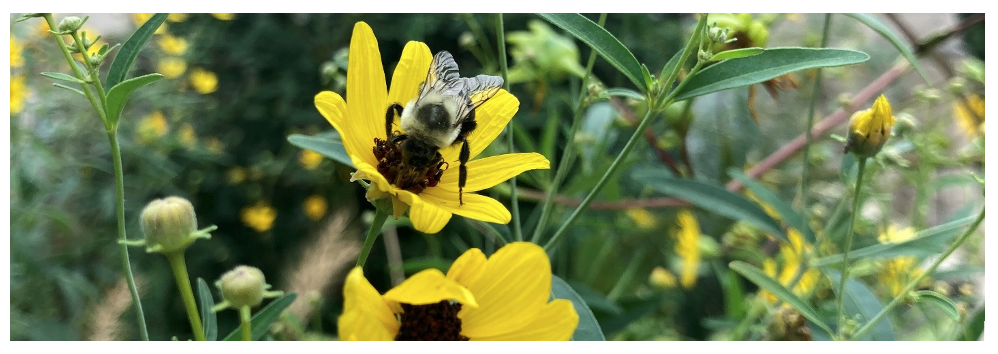
Seeds will be available during social hour following service on Sunday, October 30. Seeds from the following plants will be distributed:
- Ohio Spiderwort
- Foxglove Beardtongue
- Nodding Wild Onion
- Cup Plant
- Prairie Dock
- Tall Coreopsis
- Wild Golden Glow, Green-headed Cone Flower
- Wild Bergamot
- Big Bluestem
- Bottlebrush Grass
- Purple Joe Pye Weed
- Garden Columbine
Review descriptions of these plants below.
We will have small coin envelopes in which you may take your seeds, or you may bring containers of your own. This Sunday (October 23) there will be a sheet at the Social Justice Council table giving details about the plants in case you would like to think about which species you want. On October 30 there will also be an instruction sheet about how to plant native seeds. The seeds should be sown this fall.
October 11, 2022
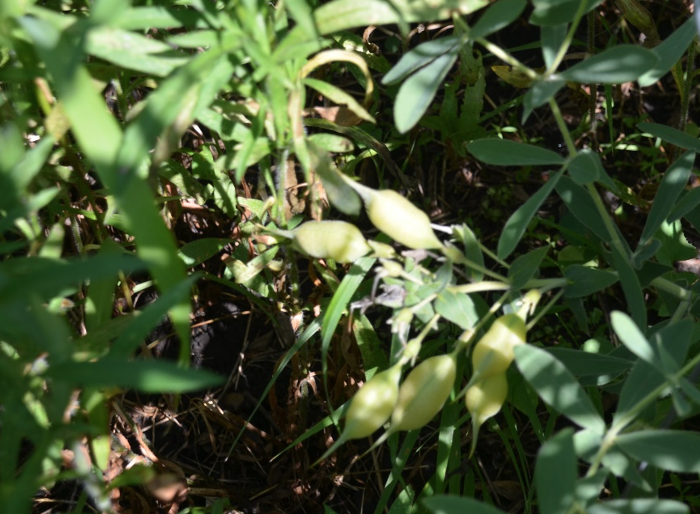
This last entry of From the Wildflower Garden describes a plant you should look for early next spring, around the middle of May. The First Unitarian Cream Wild Indigo plant is likely a nursery hybrid of Baptisia bracteata or Baptisia leucophaea. Unlike other Indigoes, Cream Wild Indigo is a low-growing plant. Its showy white to cream-colored flowers sprawl near the ground. The accompanying photo shows the pods of this legume mid-summer, developing under the vegetation that has grown up around it.
The deep roots of Indigo participate in nitrogen fixation, increasing the fertility of prairie soil. It is hard to transplant due to its deep roots and is more easily propagated by seed. However, the seeds are often difficult to harvest because weevils commonly inhabit the pods.
Because Cream Wild Indigo flowers in the cool early spring, it is often pollinated by queen bumblebees, which emerge from hibernation before the worker bumblebees. Many other types of native insects utilize the plants. They are not bothered by mammals because the foliage is quite toxic to larger animals.
The next entry for From the Wildflower Garden will be a list of the seeds of many of the plants we have described that will be available for free during social hour sometime late in October at the church. The seeds have been (and are being) collected mainly from the church garden and should be sown this fall.
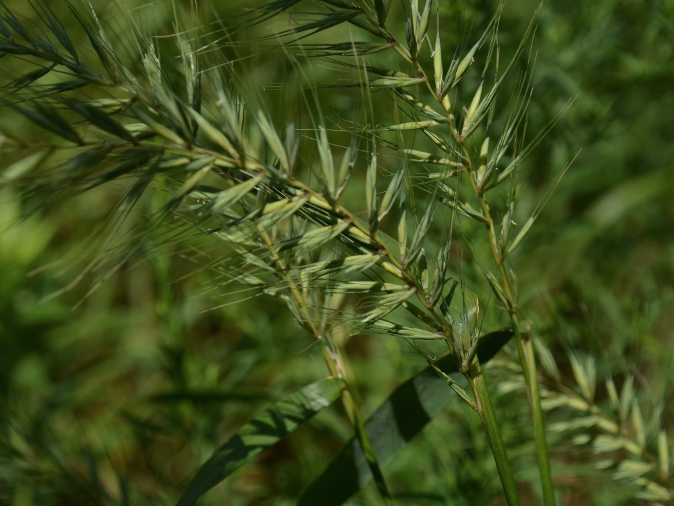
October 7, 2022
Bottlebrush grass
Hystrix patula, aka Elymus hystrix
Bottlebrush grass is easily recognized by its stiff perpendicular flowers and fruits which give the flower clusters the appearance of a bottlebrush. “Hystrix” is derived from the Greek word meaning hedgehog. The brush appearance is due to extended floral structures called awns which may reach 2.5-4 cm long.
Bottlebrush Grass is a frequent component of oak woodlands and is found throughout the state. It will flourish in shaded gardens where some sunlight reaches the soil surface. It is a cool season grass, flowering between mid-June and mid-July. The picture below was taken July 5 in the First Unitarian Wildflower Garden. After the flowers are fertilized, the seeds (which technically are fruits, i.e., grains) turn brown, and the seed clusters provide an interesting feature through midwinter, when the seeds generally are shed. All the seeds in the First U garden have been harvested to reduce next year’s population size.
As is true of most grasses, Bottlebrush Grass is wind-pollinated; the insects which are associated with it feed on the leaves, stems, and roots. In addition, vertebrates like the White-footed Mouse eat the seeds.

September 29, 2022
White Snakeroot
Ageratina altissima
Tall Boneset
Eupatorium altissimum
Two “volunteers” have found their way into most Hyde Park gardens as Fall proceeds. White Snakeroot and Tall Boneset – in the photograph – were both in the genus Eupatorium before the genus Asteraceae was rearranged. You can tell them apart by their leaves. The leaves of Tall Boneset are more than 2.5 times as long as wide, linear in shape, and are not narrowed at their bases. The leaves of White Snakeroot have a triangular shape and narrow into long petioles before they join the stem.
White Snakeroot leaves are poisonous and make the milk of cows which graze on them poisonous to humans who drink. This is how Abraham Lincoln’s mother died and what accounted for the family’s move from Indiana to Illinois (Antonio and Masi). Tall Boneset has the unusual ability to produce fertile seeds asexually, a characteristic called apomixis. Apomictic plants can produce very large numbers of seeds, all of which are adapted especially well to the environment of the parent plant which produced them.
Both plants are visited by a diversity of aphids, flies, beetles, bees, wasps, and butterflies. White Snakeroot often has thin lines on the leaves created by larvae of the leaf miner fly, Liriomyza eupatoriella. The larvae of this fly feed on the middle tissues of the leaf, the dead areas thus created forming the lines on the leaf.

September 26, 2022
Showy Goldenrod
Solidago speciosa
Showy Goldenrod is a member of the very large Goldenrod genus. Even after the genus was divided into Solidago and Oligoneuron, nineteen species of Goldenrod are listed for the Chicago region. This is the first year Showy Goldenrod has appeared in the First U garden. I planted it there with seeds from McHenry County a couple of years ago. The plant has a beautiful foot-long columnar cluster of yellow flowers. It is one of the last species to bloom on the prairie. In the Chicago Region it has been observed blooming as late as October 27. It remains beautiful even after it goes to seed with the flower clusters holding together, and potentially the entire plant turns red or burgundy after flowering (Branhagen).
Antonio and Masi cite a study that showed S. speciosa is one of the Goldenrods capable of fixing nitrogen. Legumes are the most important plants for harboring the bacteria that can add nitrogen to the soil, but this capacity in other plants like Showy Goldenrod may be locally important. Many types of insects visit the flower clusters, including an ant that continues to harvest an exudate even after the first frost. The photograph shows the rust Coleosporium asterumthat commonly infects the leaves; its alternate host is Pine species with two or three needles.
Showy Goldenrod is highly regarded as a prairie indicator. On the Coefficient of Conservatism scale of 0-10 it ranks 8.

September 18, 2022
Canada Goldenrod
Solidago canadensis
Hairy Aster
Symphyotrichum pilosum
Two native species that many people regard as “weeds” are flowering in the Garden. They are Canada Goldenrod (Solidago canadensis), which some authorities consider to be the same species as Tall Goldenrod (Solidago altissimum), and Hairy Aster (Symphyotrichum pilosum).
Two native species that many people regard as “weeds” are flowering in the Garden. They are Canada Goldenrod (Solidago canadensis), which some authorities consider to be the same species as Tall Goldenrod (Solidago altissimum), and Hairy Aster (Symphyotrichum pilosum).
Hairy Aster is found on disturbed ground where it does well because it is adapted to many and changing conditions. It is one of the first plants to appear in abandoned agricultural fields.
Goldenrod also appears on degraded land. A complex community of insects lives on the stems, leaves, and flowers of the goldenrod. For example, ldarge, round galls often appear on the stems. The galls are caused by fruit flies that lay their eggs in the stems, at the same time depositing hormones that cause the plant tissue to expand. Fruit fly larvae develop within the galls and may be preyed upon by downy woodpeckers. Also, Antonio and Masi describe how Formica ants knock beetles off the Goldenrod stems. The beetles would otherwise prey on treehoppers that the ants tend to obtain honeydew – “a liquid composed of unused portions of plant sap and waste products emitted from the anuses of treehoppers.”
Goldenrod pollen appears at the same time as fall allergies kick in, but according to Tommy Lancaster probably does not cause the allergies. “Goldenrod pollen is heavy and sticky, designed for bees and other insects to carry around, and does not drift on the wind nor go up your nostrils…The real source of the issue lies with several varieties of ragweed that also mature this time of year and send their fine pollen particles aloft on the breeze.”
September 9, 2022
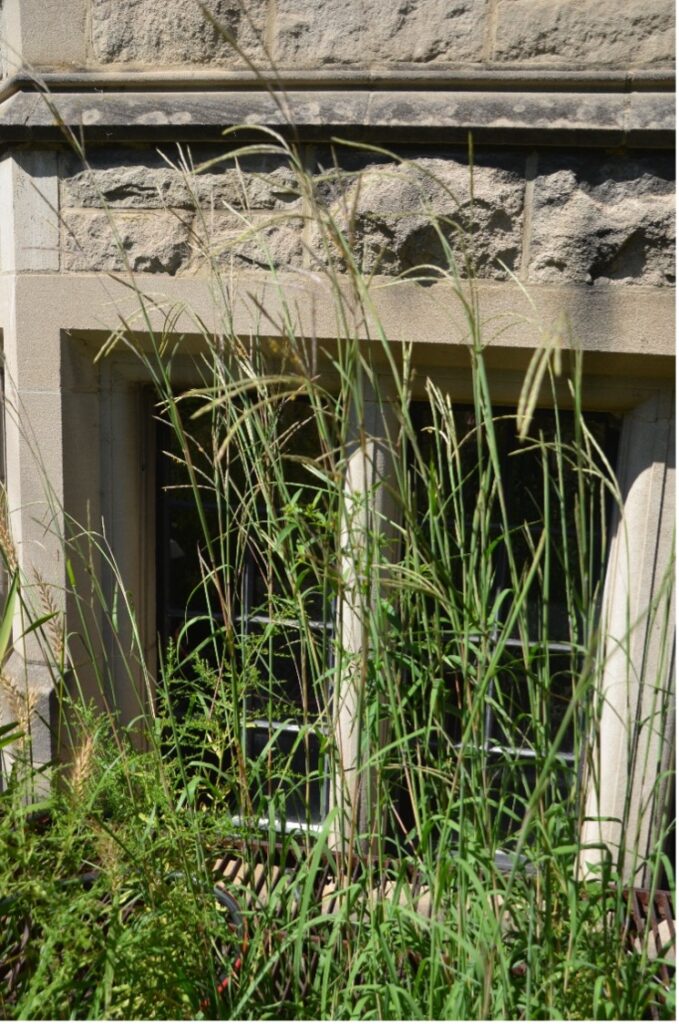
Big Bluestem
Andropogon gerardii or gerardi
Big Bluestem is a tall, late summer grass native to the Illinois prairie. It sometimes is called Turkey Foot because of the three-branched flower inflorescences, which don’t appear until July or August. This is one of the C4 grass of the prairie, meaning it has a type of photosynthesis where the first carbon product able to be isolated in the photosynthetic pathway has four carbon atoms instead of three atoms in the more widely known C3pathway. C4 photosynthesis is more efficient in hot, dry conditions. (There is also a third type of photosynthesis known as CAM.)
Roots of Big Bluestem extend six to ten feet into the soil. They also send out strong horizontal rhizomes, forming a dense sod. Thus this was one of the grasses that had to be broken by steel plows for agriculture to be successful in the Midwest.
You can see the grass in the back of the First U Wildflower Garden. Because, like most other grasses, it is wind pollinated, the flowers do not attract insects. However, butterflies and beetles feed on the leaves, stems, and roots. Wilhelm and Rericha describe mounds built by ants around the base of the plants, using the plants’ seeds in the nests. As many as twelve species of ants may coexist in these mounds in the Chicago region.
September 4, 2022

Coreopsis tripteris
Tall Coreopsis
Tall Coreopsisor (or Tall Tickseed) is another one of the plants resembling what people think of as sun flowers. Most Coreopsis species are distinguished by having 8 showy ray flowers with yellow petals which are mostly tipped with three to four teeth. In Coreopsis tripteris, the teeth are shallow and look simply like indentations at the tip of the petals. The center disc flowers are dark red brown.
Tall Coreopsis may be three to nine feet in height. The leaves are divided into three or five segments. The common name Tickseed refers to the fact that the hard black seeds look something like ticks.
According to Antonio and Masi, Tall Coreopsis is often one of the last remaining native plants in degraded prairies and, by the same token, may be easily established in prairie restorations. They may be seen throughout the First Unitarian wildflower garden. Wilhelm and Rericha describe native beetles that feed on the leaves and flowers and bees, wasps, ants, and flies that visit the flower clusters for pollen or nectar.
August 26, 2022
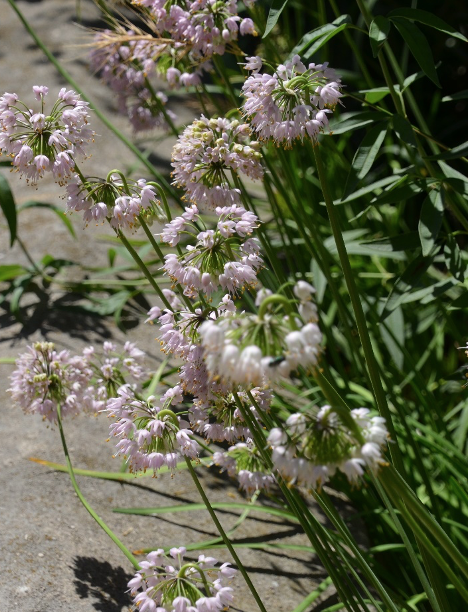
Allium cernuum
Nodding Onion
Allium cernuum is commonly called nodding onion because the flowering stem that bears a cluster of white or pink flowers at its tip bends sharply downward just below the flower cluster. With a hand lens you can also see the characteristic two-horned process on each ovary. A nectar gland is found between the two horns, and the processes provide a guide for bees probing the flowers with their “tongues.”
Both native and non-native bees visit the flowers, the non-native bees (the oblong woodcarder bee) often chasing native bees away. The Fiery Skipper is often found on the flowers as well as soldier beetles; leaf beetles attack the leaves.
Nodding Wild Onion rarely flowers before the first of July. All parts of the plant smell of onion when bruised. The bulbs and leaves were once eaten in stews or raw. However those who eat the plant need to make sure they are not consuming the one of poisonous Death Camus species, with which it may occur mainly west and south of Illinois.
August 17, 2022
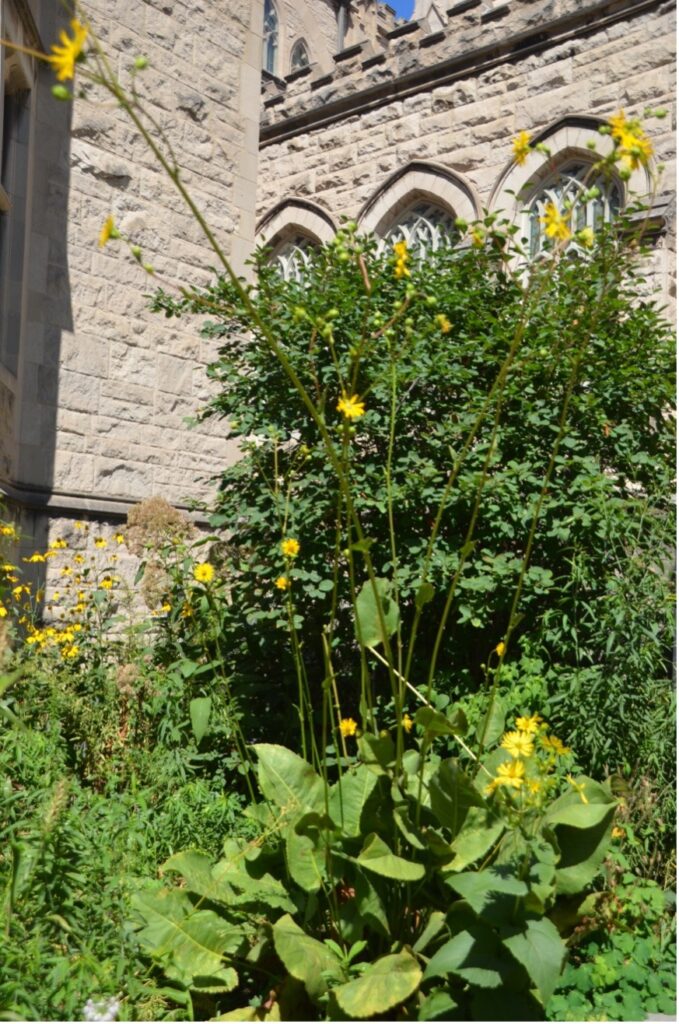
Silphium terebinthinaceum
Prairie Dock
Like its cousin the Cup Plant, Prairie Dock is an important component of prairie ecosystems. Both have deep roots that help them survive dry periods; compass plant roots may grow 10 feet deep, and Prairie Dock may go 14 feet into the soil, sometimes reaching the water table.
Additionally, Prairie Dock is adapted to dry prairie conditions by being able to orient its very large leaves so that the edges are in a north-south direction. This reduces the temperature of the leaf in the hot sun.
Both Cup Plant and Prairie Dock are very large plants. The flowers look similar, but leaves of Prairie Dock are all at the base of the plant. They have a thick sandpapery texture, particularly on the underside, and they are up to 18″ long and 12″ wide with scalloped edges. Native beetles, bees, and flies, along with the Ruby-throated Hummingbird visit the plant. Like another Silphium species, the Compass Plant, Prairie Dock is thought to live for up to 100 years.
August 11, 2022
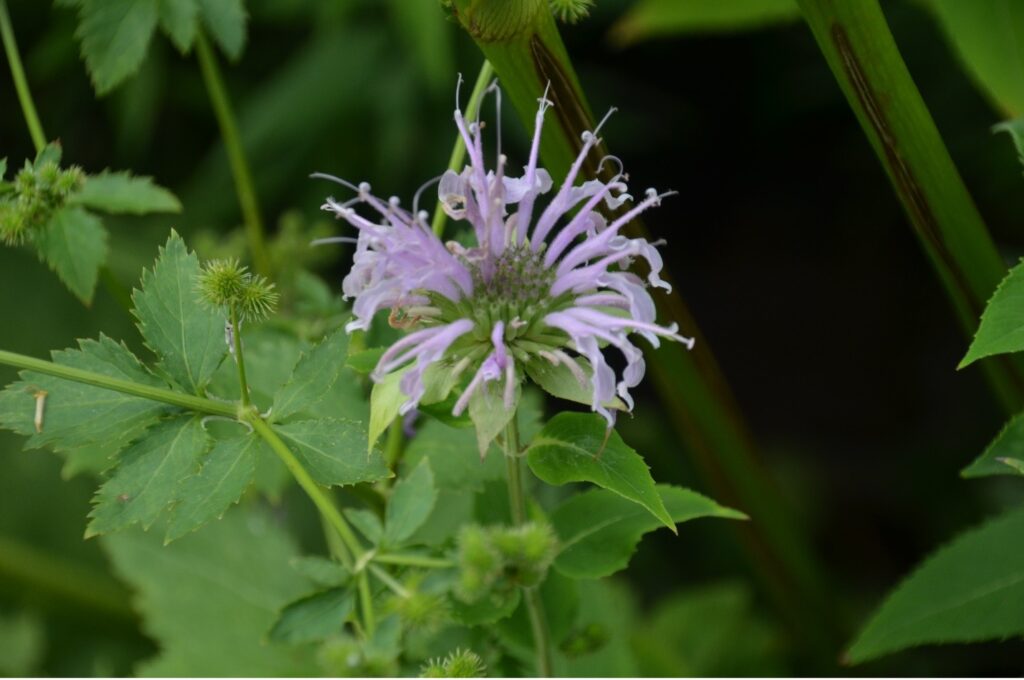
Monarda fistulosa
Wild Bergamot
This wildflower’s showy lavender flowers are clustered at the tip of the stem. Flora of the Chicago Region has a long description of the many butterflies, moths, beetles, ants, bees, and bugs that visit Monarda.
These insects have many different techniques for gleaning nectar, including siphoning it from holes at the base of the flower drilled by other insects. When the Ruby-throated Hummingbird visits the flower for nectar, it comes away with its head dusted with pale pollen. The white pollen fluoresces in ultraviolet light, providing guidance to its insect visitors. The mildew commonly infecting its leaves is part of the natural order of things and not a cause for concern.
Wild Bergamot is a member of the mint family and thus the source of several oils. Its leaves are fragrant when crushed. Bergamot oil is one of the flavoring agents of Earl Grey tea. Many Native American groups made the leaves into a tea commonly used to treat colds.
August 4, 2022

Rudbeckia laciniata
Green-headed Coneflower
The large sunflower-like plant in the middle back of the First U Wildflower Garden is Rudbeckia laciniata, commonly known as Green-headed Coneflower or Golden Glow. The common names refer to the greenish-tinged cone-like cluster of disc flowers in the middle of the “flower” (which is actually a cluster of flowers or an inflorescence) and the glowing yellow outer ray flowers which are usually bent backwards or reflexed. The leaves are deeply 3- or 5-parted.
Many native insects like the Hummingbird Clearwing moth, butterflies, bees, and bumblebees visit the flowers. Later, songbirds such as chickadees or juncos may come to harvest its seeds. The plant may reach three meters in height and blooms for two months
July 29, 2022

Eutrochium purpureum
Purple Joe-Pye Weed
Purple Joe-Pye Weed has come into flower in the back of First U’s wildflower garden. Its domes of dense pale pink flowers serve as landing pads for the butterflies and skippers that feed on its abundant nectar – Eastern Tiger Swallowtail, Hummingbird Clearwing, Pearl Crescent, Red Admiral butterflies, Silver-spotted Skipper, and Tawny-edged Skipper in the Chicago Region. It also may be visited by 15 species of native bees. In local natural areas it is often found near the edges of woodlands because the woodlands themselves have become too dense with invasive woody plants for the Joe-Pye Weed to survive.
The plant is found throughout eastern and central North America. Its clumps grow to 1.5–2.4 meters (4.9–7.9 ft) tall and about 1.2 meters (3.9 feet) wide. It is propagated easily by seed, which we will collect in the fall for anyone who would like to have some.
July 23, 2022
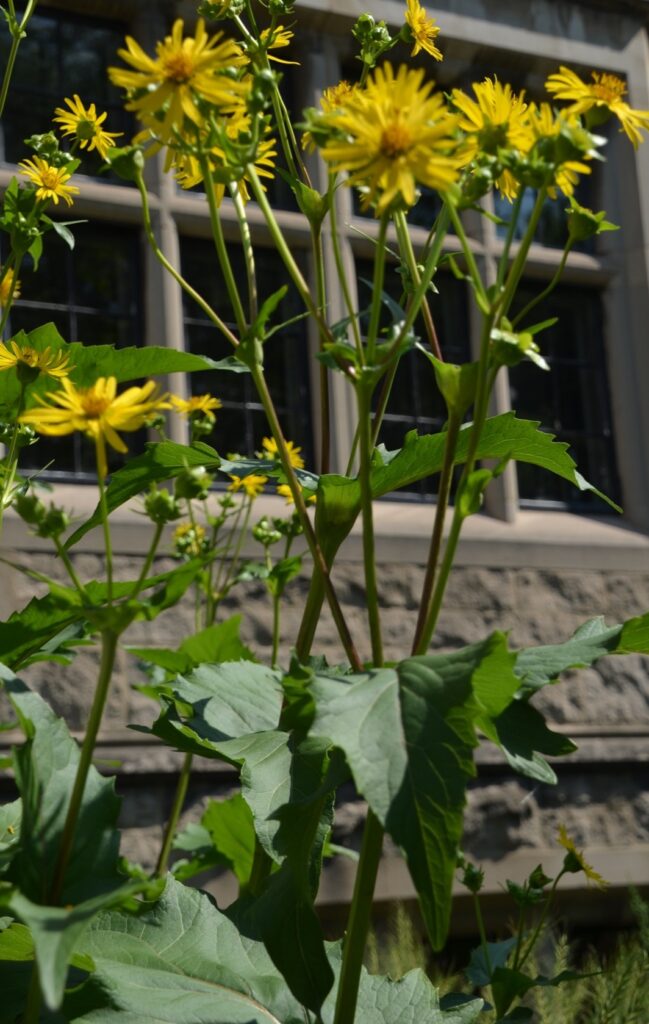
Silphium perfoliatum L.
Cup Plant
Cup Plant dominates the southwest corner of the First U garden, although we are trying to move it to the back of the garden. The plants reach 8-10 feet in height. Its opposite leaves meet at the stem, forming a cup that holds water.
The flowers attract bees, butterflies, and other beneficial insects. The long flowering period makes it especially useful for bees; the honey produced from it is rich in fructose. The cups of water are also used by wildlife. Birds are attracted to its fruit. Cup Plant is considered one of the best native plants to use for wildlife.
Cup Plant is potentially useful as an energy crop. Its colonies can be harvested for up to 20 years. However, it is potentially invasive.
July 13, 2022
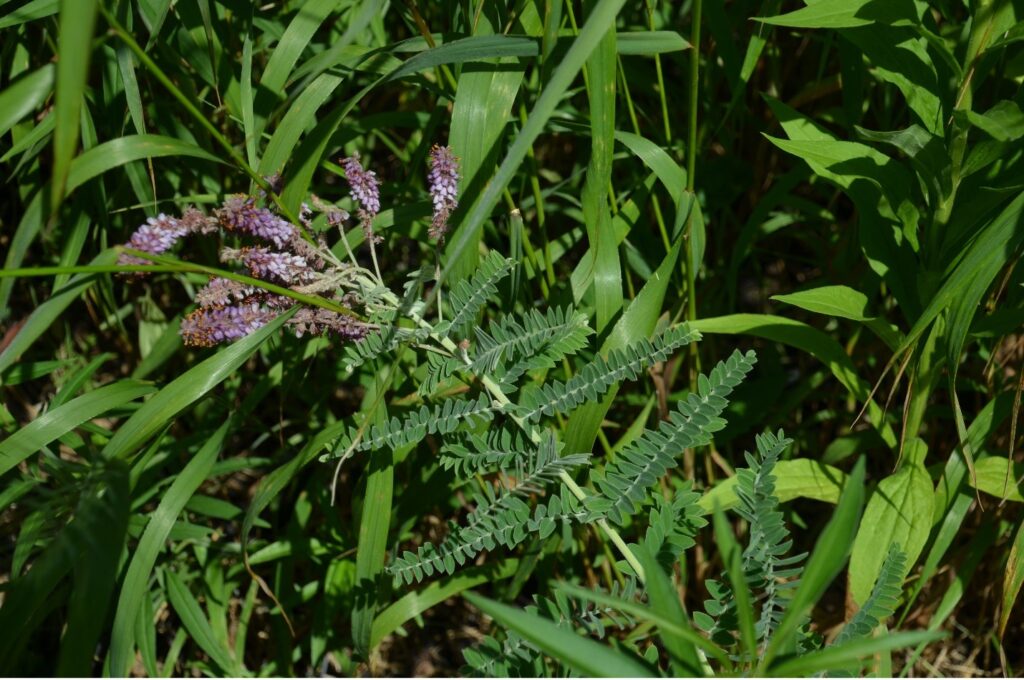
Amorpha canescens
Lead Plant
The First U garden has one Lead Plant somewhat hidden in the middle of the garden.
It “can be identified by its small purple flowers grouped in long spikes and its grey-green leaflets that are alternate and pinnately compound.”
The plant produces fruits in the form of hairy legumes each with one seed inside.” Some authorities claim that its name derives from the belief that its presence indicated lead in the ground.
Wilhelm and Rericha say that it produces an abundance of pollen and nectar and attracts an uncommonly diverse array of insect species, including butterflies, beetles, bugs, wasps, and ants. “Lead Plant is pollinated primarily by bees. The pollen-carrying structures of this group of insects are noticeable when they are laden with bright-orange pollen from the flowers of this plant. In the Chicago Region alone, 81 species or about 20% of the region’s known bee fauna visit the flowers.”
July 7, 2022
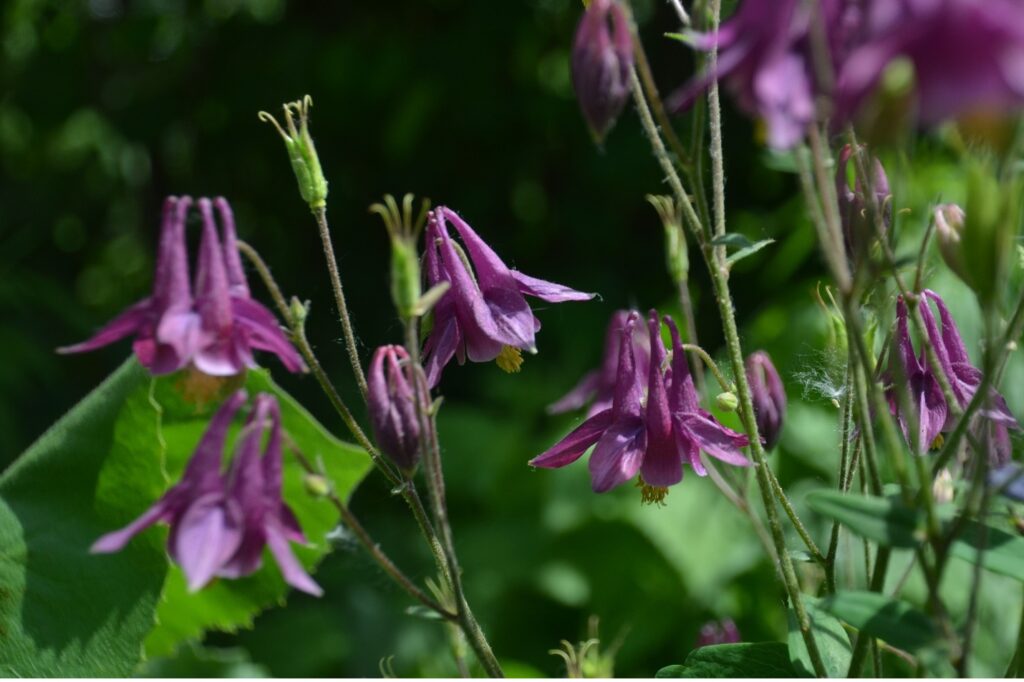
Aquilegia vulgaris L.
Garden Columbine
This non-native species is usually some shade of blue, purple, white, or pink, whereas the native Columbine is red, orange, or yellow.
Native Columbine flowers have straight spurs; Garden Columbine flowers have spurs that are strongly hooked. Its sap may irritate the skin. Hummingbirds and butterflies are attracted to the flowers, but they are ignored by rabbits and deer. Most of the flowers in the First U garden (July 5) have “gone to seed,” i.e., the showy petals have fallen, and the ovaries have turned into fruits as their contained seeds ripen.
June 16, 2022
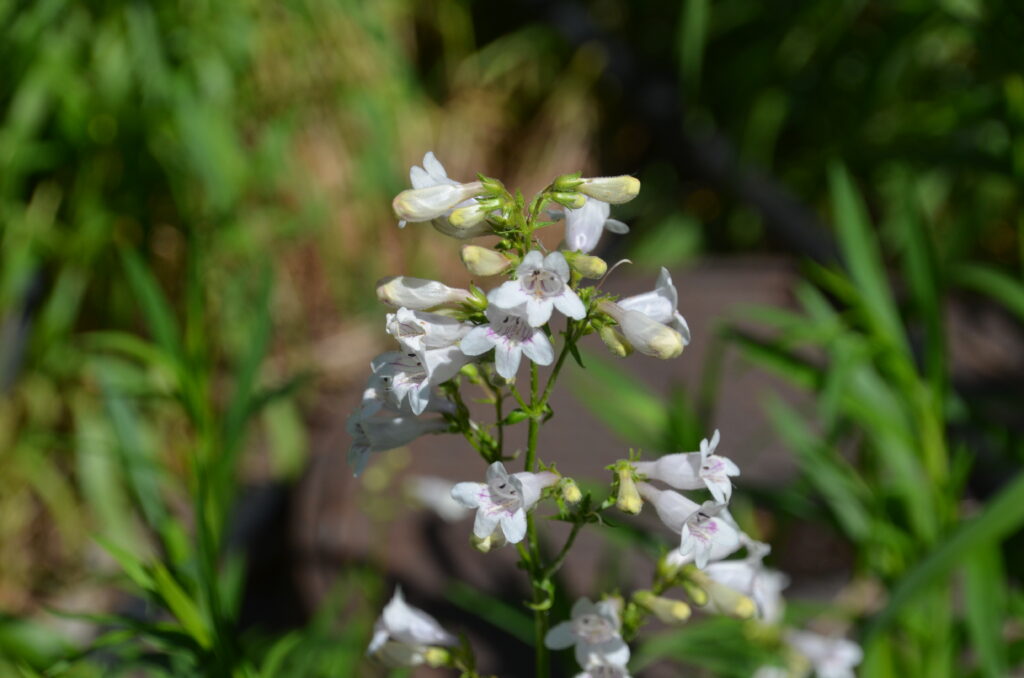
Penstemon digitalis
Foxglove Beard Tongue
Penstemon is a native plant that is flowering now in many Hyde Park gardens, including First U’s (see photo). It is often planted with Spiderwort because they flower at the same time and their purple and white flowers contrast nicely. Its common name refers to the fact that its finger-like petals resemble the plant Digitalis (Foxglove). According to Alan Branhagen, the white flowers glow in the dark, attracting pollinating sphinx moths.
Among its other pollinators are Ruby-throated Hummingbirds and 24 species of native bees in the Chicago region. Taxonomists have recently moved Penstemon from the Figwort family (Scrophulariaceae) to the Plantain family (Plantaginaceae).
June 10, 2022
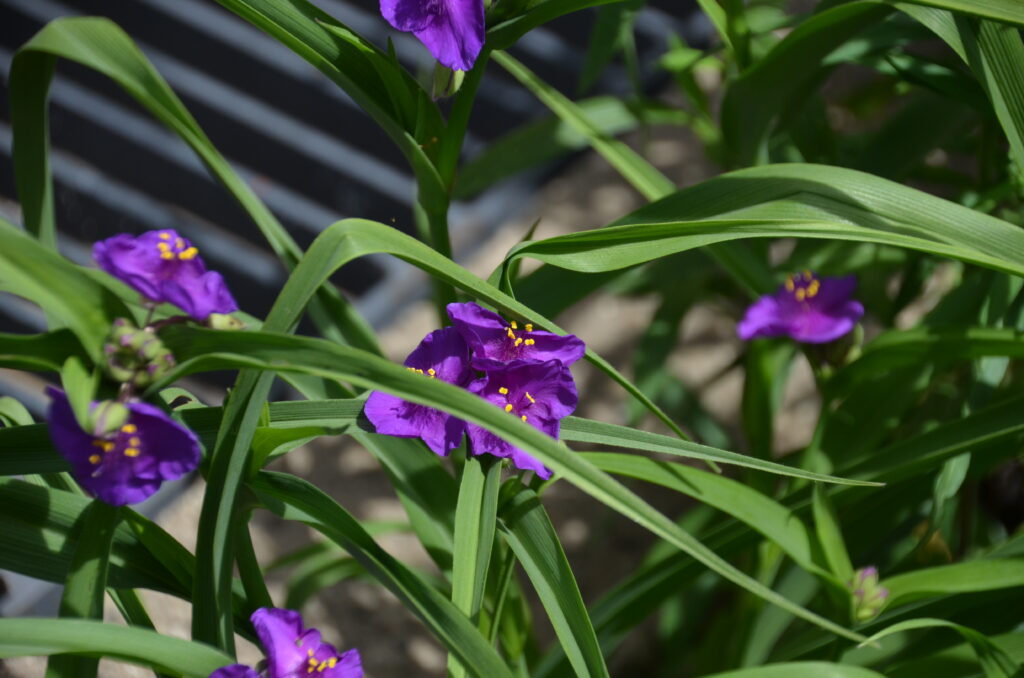
Tradescantia ohiensis
Ohio Spiderwort
Ohio Spiderwort has been blooming in the wildflower garden outside Chris Moor Parlor for a couple of weeks. Spiderwort flowers last for just a single day. When the flowers open at dawn, the fluid from inside the sepals (green part of the flower) concentrates or collects in the concave sepal bases.
The fluid surrounds the base of the ovary in the center of the flower and glistens in the sun. Insects, especially bees, visit the flowers early in the day to glean this fluid. Twenty-one species of native bees are known to visit Ohio Spiderwort flowers in the Chicago region. (information mainly from Flora of the Chicago Region by Wilhelm and Rericha)
The formal name of Ohio Spiderwort is Tradescantia ohiensis, and it is in the Spiderwort Family (Commelinaceae). This native plant may form hybrids with at least nine other species of Tradescandia.
